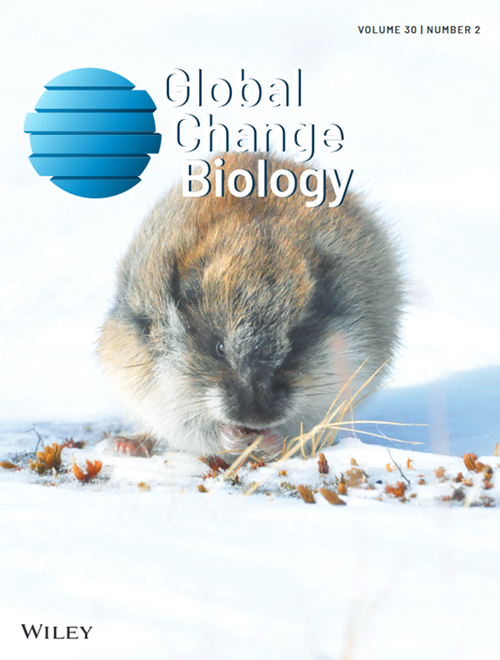Adaptation to climate change through seasonal migration revealed by climatic versus demographic niche models
IF 12
1区 环境科学与生态学
Q1 BIODIVERSITY CONSERVATION
引用次数: 3
Abstract
Predicting the geographic range of species and their response to climatic variation and change are entwined goals in conservation and evolutionary ecology. Species distribution models (SDMs) are foundational in this effort and used to visualize the geographic range of species as the spatial representation of its realized niche. SDMs are also used to forecast range shifts under climate change, but often in the absence of empirical evidence that climate limits population growth. We explored the influence of climate on demography, seasonal migration, and the extent of the geographic range in song sparrows (Melospiza melodia), a species thought to display marked local adaptation to regional climate. To do so, we developed SDMs to predict the demographic and climate niches of migratory and resident song sparrows across our study area in western North America from California to Alaska, using 48 years of demographic data from a focal population in British Columbia and 1.2 million continental‐scale citizen science observations. Spatial agreement of our demographic and climate niche models in the region of our focal population was strong (76%), supporting the hypothesis that demographic performance and the occurrence of seasonal migration varied predictably with climatic conditions. In contrast, agreement at the northern (58%) and southern (40%) extents of our study area was lower, as expected if the factors limiting population growth vary regionally. Our results support the hypothesis that local climate drives spatial variation in the occurrence of seasonal migration in song sparrows by limiting the fitness of year‐round residents, and suggest that climate warming has favored range expansions and facilitated an upward shift in elevational range song sparrows that forgo seasonal migration. Our work highlights the potential role of seasonal migration in climate adaptation and limits on the reliability of climate niche models not validated with demographic data.

气候与人口生态位模型揭示的季节性迁徙对气候变化的适应
预测物种的地理范围及其对气候变化和变化的反应是保护和进化生态学中相互交织的目标。物种分布模型(SDMs)是这项工作的基础,用于将物种的地理范围可视化为其实现的生态位的空间表示。sdm也用于预测气候变化下的范围变化,但往往缺乏气候限制人口增长的经验证据。本文探讨了气候对鸣麻雀(Melospiza melodia)的人口统计学、季节性迁徙和地理范围的影响,这种物种被认为对区域气候具有明显的局部适应性。为此,我们开发了SDMs来预测从加利福尼亚到阿拉斯加的北美西部研究区域内候鸟和常驻鸟的人口和气候生态位,使用了来自不列颠哥伦比亚省焦点种群的48年人口数据和120万大陆尺度的公民科学观测。我们的人口和气候生态位模型在焦点人群区域的空间一致性很强(76%),支持了人口表现和季节性迁移发生可预测地随气候条件变化的假设。相比之下,如果限制人口增长的因素因地区而异,那么我们研究区域北部(58%)和南部(40%)的一致性较低。我们的研究结果支持了局部气候通过限制终年居住的鸣禽的适合度来驱动鸣禽季节性迁徙发生的空间变化的假设,并表明气候变暖有利于鸣禽范围的扩大,并促进了鸣禽放弃季节性迁徙的海拔范围向上移动。我们的工作强调了季节性迁移在气候适应中的潜在作用,以及未经过人口数据验证的气候生态位模型可靠性的局限性。
本文章由计算机程序翻译,如有差异,请以英文原文为准。
求助全文
约1分钟内获得全文
求助全文
来源期刊

Global Change Biology
环境科学-环境科学
CiteScore
21.50
自引率
5.20%
发文量
497
审稿时长
3.3 months
期刊介绍:
Global Change Biology is an environmental change journal committed to shaping the future and addressing the world's most pressing challenges, including sustainability, climate change, environmental protection, food and water safety, and global health.
Dedicated to fostering a profound understanding of the impacts of global change on biological systems and offering innovative solutions, the journal publishes a diverse range of content, including primary research articles, technical advances, research reviews, reports, opinions, perspectives, commentaries, and letters. Starting with the 2024 volume, Global Change Biology will transition to an online-only format, enhancing accessibility and contributing to the evolution of scholarly communication.
 求助内容:
求助内容: 应助结果提醒方式:
应助结果提醒方式:


